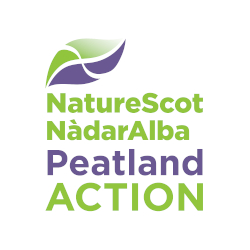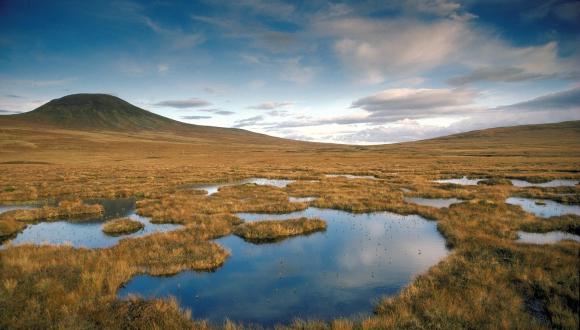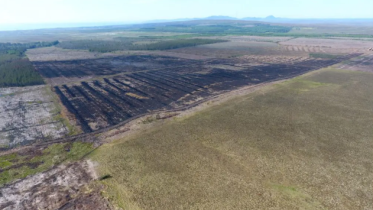Peatland ACTION - Technical Compendium - Restoration - 5 Bunding intervention

5. Bunding interventions above and below ground
Objectives of bunding techniques
Hydrological intervention may be required not only in artificial drain channels but may be necessary to stop subsurface flow and water loss from an area or to stop surface flow of water to reduce water loss and erosion. In some instances, both surface and subsurface intervention is required. The term used for this is bunding.
Many of these techniques have largely been used in raised bog restoration. It is important to think carefully about the possible impacts and appropriateness of some of these techniques when restoring blanket bogs.
General guidance and principles - read me first
Terminology
Bunding is a technique that aims to retain water on site, by either creating internal peat dams to impede water movement through the peat body and/or surface bunds to hold back surface water in shallow pools. This family of techniques is typically used when a peatland is persistently dry or there are lots of peat pipes/cracks within the peat body and is a common restoration technique of lowland raised bogs and on large expanses of bare peat. Bunds can also “isolate” an area hydrologically from the surrounding area (e.g., it may not be feasible to block a boundary drain if land ownership varies either side), again making them suitable for lowland raised bog restoration where there is an artificial drained or cut edge.
There are different types of bunding:
• Deep bunding is used to overcome cracks and pipes in deep layers of peat, or to catch and hold rainfall and slow the lateral (internal) movement of water.
• Surface bunding is most usually used where there is need to impede or slow down/disrupt surface flow over bare peat. It is often used on wide but shallow features that lead to water loss (such as a wide and shallow gully, or large bare peat pans). Surface bunds help to retain water locally behind the bund, in small pools so as to not create a large body of water where edges would be disturbed by the action of wind. Surface bunding in the context of gully blocking and bare peat restoration on blanket bog is described further in Section 6 and specifically in Section 6.1.
General guide
• Check first whether a Controlled Activities Register Licence is required from SEPA and whether the site is subject to other constraints.
• As bunding, particularly deep bunding, can impede water over large areas, it is important to consider the impact of bunding on peat stability. Peatland ACTION projects require a peat slide risk assessment to be carried out to inform the design stage of any restoration project.
• Understanding slopes, particularly on lowland raised bogs, is particularly important as installing bunds without consideration of changes in topography, particularly towards the edge of a peatland, can impact their stability. Bunding is therefore best planned and delivered when the slope of the site is easily visualised, for example on forest to bog projects after the point of tree or scrub removal.
• In most instances, but particularly on lowland raised bogs with modified/artificial edges, a 20 m buffer will be required from the peatland edge before bunds are installed.
• Where there are dips and low points in the topography of the peatland, particularly towards its edges, bunds should be contoured around these features rather than cut through them (see diagram). Any features that focus water flow should be carefully considered as a feature that focuses water movement and flow on a bund structure can lead to weakness in the bund, instability and potentially bund failure and a peat slide.
• All peat bunds, deep and surface, should use good quality peat and woody debris should not be incorporated. Bunding is therefore best carried out within a year of scrub removal, before there is sufficient time for regen to re-establish, to reduce the amount of woody material on site.
5.1 Deep Bunding
5.1. Deep Bunding
Aim of the Technique
Deep bunding is used to overcome cracks and pipes in deep layers of peat, or to catch and hold rainfall and slow the lateral (internal) movement of water. It has largely been used in raised bogs. There are various different terms in use to describe bund types but the majority describe internal (sub-surface) bunds with or without a surface bund.
• Trench bunding: a long internal peat dam within the peat. Useful on sites where there is considerable pipe flow (peat pipes) and cracked peat. Often used on edges on lowland raised bogs, following contours. Trench bunds are usually associated with small surface bunds.
• Back-filled trench: a trench bund without the surface bund. Used to counteract peat cracking underneath the furrows, but does not hold back surface water as a trench bund would. Often used on forest to bog projects where peat cracking may be present underneath the furrows.
Best Practice
• Ensure that the excavator has sufficient reach to work at a deep enough depth when trench bunding and that excavators are manoeuvred to allow machine operator to spot cracks or pipes that need to be blocked.
• When trench bunding the borrow pit should be behind (upstream/uphill of) and not in front of the bund.
• When bunding over an existing drain, a trench bund put through the drain is necessary to prevent the loss of water or water flowing around the drain. Putting a bund through a drain feature could become a weak point in the bund unless the drain has been blocked sufficiently upstream.
• Excavate the trench to the depth of any cracks, peat pipes or oxidised peat, removing the turf and any oxidised peat and putting to one side. Fill the trench with unoxidized peat, taken from an adjacent borrow pit. The turf of the borrow pit should be removed and put to one side along with any oxidised peat. Use the unoxidized peat from the borrow pit to fill in the trench and compact to create a peat dam within the peat body. Form a low surface bund of no more than 25cm to intercept surface flow and cap with the retained turf. Back fill the borrow pit with degraded peat, reprofile to shallow the angle and stretch the turf to minimise any bare peat
• Trench bund depth depends on the depth required to expose and remediate the drainage features (i.e., peat pipes). Trench bunds may need to go to about 2 metres, or more in particularly degraded sites (such as when a site had previously been afforested with lodgepole pine). The depth of trench bunding will have an impact on progress; if digging deep, progress may only be about 50 m per day.
• Trench and backfilled trench bunds should be very well consolidated with great care taken to ensure good quality peat has been tamped down into the trench and built up layers are well compacted together.
• When trench bunding (deep bund with surface bund) ensure the surface bund is well turfed and stable.
Appropriate Machinery
• 7-13 tonne low ground pressure excavator on very wide tracks.
• A tilt rotator bucket gives a machine operator greater dexterity and may help to reduce tracking. However, this type of bucket will not go as deep as standard bucket so site conditions need to be considered (i.e., depth of cracking).
When most likely to succeed
• When contractors understand the outcome very well and are experienced.
• When trenches are deep enough and backfill material is well compacted.
• When there is no woody debris in the peat.
When most prone to failure
• If bunds are built too high or substantial and hold too much water – this increases pressure on the bund and large pools of water form, inhibiting Sphagnum growth.
• When trenches are not dug deep enough to get to layers of cracking or pipes, or not compacted enough to ensure a seal.
• If there are breaks in the bunds during construction - these will become points of failure in the future.
• When roots and woody materials are incorporated into the bunds.
• If machine tracking has not been carried out sensitively; it is imperative that machines do not track consistently in front of any bund created (can weaken the structure)
• Peat stability needs to be considered from the outset. Peat slide risk assessments should consider potential impact of bunding and peat slide risk over the wider area.
Points to Remember
• Trench bunding is about stopping internal through-flow of water or flow of water in peat pipes rather than creating lots of pools of surface water.
• Deep bunding can lead to rapid rewetting of an area so it is essential machine tracking and movement across the site has been considered (particularly if the project is to be phased over a number of years; rewetting activities can not impede access for future phases of restoration.
• Bund height is important to consider. Surface bunds, particularly those which are higher, can be very visually striking and can dramatically change the landscape of a peatland. Pools created behind surface bunds may need seeded with Sphagnum to help with the revegetation and infilling process.
• There is a risk of peat slides with this technique, as it can hold back a lot of water in degraded peat which can be less stable. This is a particular concern on edges of lowland raised bogs which are dry (e.g., where there may be boundary drains, artificially cut edges, established tree/scrub growth) or have rapid and significant changes in topography (e.g., artificially cut edge).
Further Guidance & Support
Peatland ACTION Project Officers are available to help you with your project. Please contact us as at [email protected] to be put in touch with your local Officer.
Peatland Action - A short video explaining the techniques for bunding on peatlands.
5.2 Surface Bunding
5.2 Surface Bunding
Aim of the Technique
Surface bunding is mostly used where there is a need to impede and/or disrupt surface flow over bare peat. It is often used on wide but shallow features (such as a wide, shallow gully, or large bare peat pans) that lead to water loss. Surface bunds help to retain water locally behind the bund, in small pools so as to not create a large body of water where edges would be disturbed by the action of wind. Different designers and contractors will have different terms which help describe the layout/orientation of surface bunds:
• Cell bunding: The joining up of surface bunding to create cells which hold back water on the surface (so not always associated with a deep bund).
• Fish-scale or scallop bunding: Curved surface bunding (not necessary into enclosed cells) with or without associated deep bund.
• Finger tie backs: refers to linear bunds which have bunds crated perpendicular to the main bund (usually not curved as per fish scale or scallop bunding) and can be with or without associated deep trench.
• Gully bunds/blocking: refers to structures installed in gullies (usually in the context of upland bare peat restoration projects) to slow/disrupt surface water flow. Surface bunding in the context of gully blocking and bare peat restoration is described further in Section 6.
Best Practice
• In high surface water flow situations, it is better to use surface bunds with gaps, i.e., fish-scale or scallop bunds, so that water can pass through. Such bunds can be used on edges of raised bogs to stop surface water accumulating in areas where this isn’t desired.
• Ensure cells/areas of surface water are not too large; wave action over larger pools can cause erosion of the bunds. Rule of thumb is not to have cellular bunded cells too large (10 x 10 m). Ensure the design of pools through cell bunding avoids channelling water into the edges of e.g., raised bogs, consider the overall shape of the site in the design.
• Pools may need to be seeded with Sphagnum.
• Surface bunds should be well-capped with vegetation, which would then help to colonise the pools.
• Linear bunds should have “tie-backs” or finger bunds every 20-25 m minimum, these can be 5 m long.
• The final height of the surface peat bund is usually around 250-300 mm above the peat surface. Bear in mind that peat features will settle.
• In sites with bare peat, geotextiles should be considered for bund tops.
Appropriate Machinery
• 7-13 tonne low ground pressure excavator on very wide tracks.
• A tilt rotator bucket gives a machine operator greater dexterity and may help to reduce tracking.
When most likely to succeed
• When contractors understand the outcome very well and are experienced.
• When topography of the site has been carefully considered and bunds used to back water up slope
• When there are multiple bunds (cellular or otherwise connected such as fish scale or tie backs) to reduce the pressure on any one bund and reduce risk of bund failure
• When constructed using good quality peat and without woody debris incorporated into the bund
When most prone to failure
• If bunds are built too high or substantial and hold too much water – this increases pressure on the bund - or when the cells created by the bunds are too large and large pools of water form, inhibiting Sphagnum growth.
• If there are breaks in the bunds during construction - these will become points of failure in the future.
• If grazing pressure is high and deer/livestock use deep bunds as routes across, this can cause erosion. Surface bund structure would have to be carefully considered to ensure they could withstand tracking (e.g., ensure they are very well turved and not too narrow).
Points to Remember
• There is a risk of peat slides with this technique, as it can hold back a lot of water in degraded peat which can be less stable. This is a particular concern on edges of lowland raised bogs or if underlying geology is weak.
• Bund height is important to consider. Surface bunds, particularly those which are higher, can be very visually striking.
Further Guidance & Support
Peatland ACTION Project Officers are available to help you with your project. Please contact us as at [email protected] to be put in touch with your local Officer.
Further Guidance & Support
See our technical compendium for other techniques in the series.
Peatland ACTION Project Officers are available to help you with your project. Please contact us as at [email protected] to be put in touch with your local Officer.




